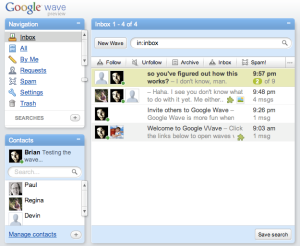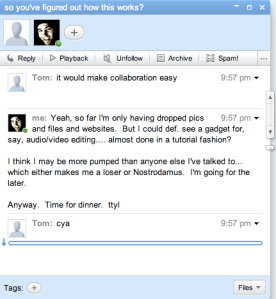A few months ago, I documented my first trip to ride Google’s new Wave. In full disclosure, since that time, I’ve been back only a handful of times. Through exchanges with students, friends, and co-workers, I’ve found this to be the case for a majority of “Wave” users… or potential Wave users. My own hypothesis: Google attempted to re-invent the wheel. A wheel that they already possessed and improved. A clear example is listed just below:
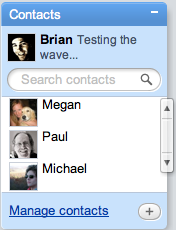 To the left is a “Google Wave” contact list. When I first joined, there were only a few people who were on my contact list. Though I frequently chatted with friends using GMail‘s “Gtalk” (commonly referred to as “gchat” by many) feature already, I (and the rest of my friends) joined Google Wave hoping to find something different.
To the left is a “Google Wave” contact list. When I first joined, there were only a few people who were on my contact list. Though I frequently chatted with friends using GMail‘s “Gtalk” (commonly referred to as “gchat” by many) feature already, I (and the rest of my friends) joined Google Wave hoping to find something different.
What we found though, was not only something that we had used seamlessly in our day-to-day electronically mediated interactivity, but also something that didn’t include everyone we were used to interacting with. It was a cheap imitation and lacked the social component that drives electronically mediated interactivity in today’s culture and society.
To the right is a 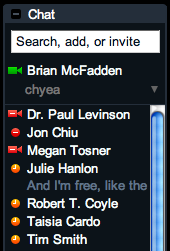 screen shot of my own gtalk contact list located within my Gmail window. Immediately, the anatomy gtalk’s contact list reveals more people, a video chat option, and (most important of all) more users! The third of these three characteristics was the most damning of Google’s Wave from the start. Google, hoping to spark electronic phylogenic progress with Google Wave, remained stagnant if not receding due to the lack of users.
screen shot of my own gtalk contact list located within my Gmail window. Immediately, the anatomy gtalk’s contact list reveals more people, a video chat option, and (most important of all) more users! The third of these three characteristics was the most damning of Google’s Wave from the start. Google, hoping to spark electronic phylogenic progress with Google Wave, remained stagnant if not receding due to the lack of users.
Judging by Google’s introduction of “Google Buzz” as an application on it’s gtalk, the company realized this was a major flaw in the makeup of Wave. The nonverbal omission of failure resulted in yesterday’s worldwide introduction of Buzz and today’s worldwide unveiling on many Gmail/gtalk users’ windows.
Instantly, users liken Google Buzz to Twitter. It’s hard not to. From the ability to “link” (or sync) to your Twitter account to the terms “follow” and “follower,” Buzz reeks of Twitter. Below is a visual example of this:
 Just above was my last “tweet” before going to bed…
Just above was my last “tweet” before going to bed…
 Today, when I activated my “Buzz,” this was the result of “linking” (or “syncing”) my “tweets” into Google Buzz.
Today, when I activated my “Buzz,” this was the result of “linking” (or “syncing”) my “tweets” into Google Buzz.
Google Buzz’s central separation from Twitter is something that my Communication and Media Studies recitation group and I discussed yesterday during class. The lack of opportunities for “public feedback” on Twitter requires users to take extra steps to “see” what other people are commenting about any given “tweet.” An example of this is displayed just below:
 Paul Levinson‘s initial tweet about last night’s Lost episode appeared on my Twitter feed without any alert as to other people who’ve commented or responded to his initial commentary.
Paul Levinson‘s initial tweet about last night’s Lost episode appeared on my Twitter feed without any alert as to other people who’ve commented or responded to his initial commentary.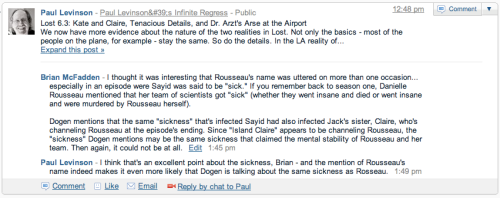 The very same tweet (“linked” or “synced” from Paul’s Twitter account right into Google Buzz) makes public commentary or feedback a possibility. Further, private feedback via chat (both textual and video) is also an option for users.
The very same tweet (“linked” or “synced” from Paul’s Twitter account right into Google Buzz) makes public commentary or feedback a possibility. Further, private feedback via chat (both textual and video) is also an option for users.
If Google Buzz can wrangle users in a way that the company was unable to do with Wave, this addition to GMail will be a wild success. The pressure and attention now moves to Twitter. The social networking, micro-blogging site must now take steps to making public feedback more visible to users. Failure to do so, may result in a decrease in activity and more web hours being spend micro-blogging on Google Buzz.












